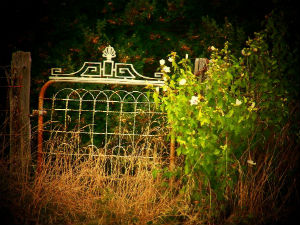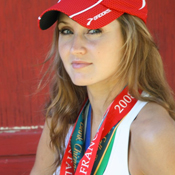What Once Was Lost
A friend from New York City is staying with us this weekend and, as is always the case when an out-of-town guest happens to run, I have spent a good deal of time planning routes that are both appropriate to the runner and representative of the glorious running Elysium that is St. Louis and its surrounding counties.
I also assume the mantle of cicerone. It is a solemn responsibility, part tour guide, part host of This Is Your Life. Only it’s my life—or, more specifically, the roads I grew up running—and my guest isn’t so much a guest on the show as he is a member of the audience.
“This is the road I used to run with my dad every Saturday morning,” I say. “And over there—” pointing to a white barn surrounded by pasture—“that’s where I took horseback riding lessons when I was 11.”
“Ah…”
“And see that old train station?”
“Yes.”
“Well, it used to be a train station.”
…
“Like, a working train station,” I reiterate, losing confidence, “with trains…”
I told this last fact to Jake, eight years ago. It is a disclosure I regret to this day, for obvious reasons.
I become hypersensitive to the scenery when I plan running routes for out-of-town guests. Is the stretch along the industrial park too unsightly? Is the sidewalk too suburban? Are the trees along this part of the trail special? Or are they just run-of-the-mill? Is the flat part too long? Is the hilly part too hilly? How do the bluffs overlooking the Missouri River compare to the Grand Tetons? Or Vermont? Or Central Park?
I feel the weight of my city upon my shoulders, where a racerback sports bra leaves a stark white tan line in the shape of the flux capacitor on my back. One ill-advised mile, and the reputation of the St. Louis running scene could be discredited.
In the end, I decided on a route that would take us up and over the Missouri River bluffs (tour guide!) and through the woods to an old hunting trail where I once got lost and thought I was going to die (This Is My Life!).
Only after I picked the route did I realize it had been quite some time—years—since I had last run it. Time is funny that way. Life fades and flickers from one thing to the next. We move on from this or that without realizing we’re moving at all. And then, suddenly, we find that what once was part of our daily routine has receded from the picture entirely. It is a strange phenomenon.
Since I couldn’t even remember the last time I ran the route, I figured a test run was in order. It was noon and very hot, but it was my only chance to squeeze in the run, so noon and very hot it had to be.
 As I ran over the bluffs, catching glimpses of the Missouri River far below, surrounded by cornfields and a thick, humid haze, I was hurtled back to the summer I turned 16, when I ran once a week with Bill, who was a senior and a lifeguard at the pool. Bill was the one who showed me the old hunting trail. We had to skirt a rusty gate and push our way through some brush to get there. The trail cut through the woods for miles before it dumped us back on the main road. The old gate, the dilapidated deer stands plunked in the trees, the dirt path shrinking to a single track, the secret solitude—the whole thing felt like an adventure.
As I ran over the bluffs, catching glimpses of the Missouri River far below, surrounded by cornfields and a thick, humid haze, I was hurtled back to the summer I turned 16, when I ran once a week with Bill, who was a senior and a lifeguard at the pool. Bill was the one who showed me the old hunting trail. We had to skirt a rusty gate and push our way through some brush to get there. The trail cut through the woods for miles before it dumped us back on the main road. The old gate, the dilapidated deer stands plunked in the trees, the dirt path shrinking to a single track, the secret solitude—the whole thing felt like an adventure.
One day, late in the summer when Bill was on a family vacation, I tried to run the trail solo. After a couple of failed attempts, I found the trailhead and darted into the woods. The path seemed different now that I was alone. With Bill, the path was friendly and enticing and ours. Alone, it seemed aloof, longer, and more difficult to navigate. Side trails I had never before noticed branched off in perpendicular contradiction. I continued running, my pace slowing as my confidence faltered. I doubted the path. I doubted myself. I felt very alone and very far from home.
After several miles, certain I was lost, I turned around.
As it happened, I hadn’t been lost. I was mere yards from where the path made a sharp turn and would have deposited me onto the main road had I simply kept running. But in my uncertainty and fear, I had turned around just steps from the finish.
Now, years later, as I made the final ascent over the bluffs before the rusty gate, I remembered how afraid I had felt, and I anticipated the looming solitude of the trail.
Only, the trail never came. The rusty gate was gone. The trees had been cleared. Where once a dirt path had furtively cut a course through the woods, a black asphalt road wound its way through the hills with broad and brazen self-assurance. I continued running, following the road and feeling nothing of the remote solitude that once existed in that very spot. A few houses dotted the landscape. The landscaping was pristine. An iron gate—automatic, with a keypad—stood sentry at an intersection. I ran around one of the stout brick pillars bookending the gate and, just like that, was back on the main road.
It was strange. Once, in that very spot, I had felt so lost that I had abandoned my journey and turned back. Now the road was unmistakable and smooth. I couldn’t help but laugh. Who would have known?
I thought about the old trail and the new road as I ran back to my car. Yes, the trail may be gone, but that feeling of being lost, of being alone on the wrong path, never quite disappears. Sure, it may vanish for awhile, dissolving like the Cheshire cat—a tail, a head, a smile at a time—but sooner or later it returns, in a new form.
“Are you sure this is the right way, my dear?” it asks with an oily tone. “Perhaps you should have taken the other…?”
Every statement is a question. Every question instills doubt.
“Should you really keep going deeper into the woods? You are awfully alone, you know…”
Fear makes its home in the unknown, the unconventional, and the unexpected. But so does adventure. The key is to keep pressing forward—to keep charging down the path—even when it is longer and harder to navigate than you could have anticipated.
Just because you feel lost doesn’t mean you are lost. Because what once was a trail, terrifying and lonely, may become road. And one day, you may stand and laugh at how frightened you were not so long ago.

Amy L. Marxkors is the author of The Lola Papers: Marathons, Misadventures, and How I Became a Serious Runner and Powered By Hope: The Teri Griege Story. Click here to receive Amy's weekly article via email.
Connect With Us
See the latest from Fleet Feet St. Louis